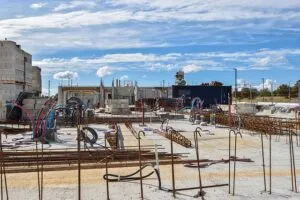Residential foundation stabilization is crucial for maintaining homes' structural integrity against shifts, settlements, and damage caused by soil conditions, construction flaws, water changes, or natural disasters. Understanding this process involves assessing foundation types, identifying damage (cracks, stuck doors, uneven floors), and employing professional Foundation Solutions like underpinning, piercing, or support beams to stabilize, repair, and strengthen foundations. Modern advancements in Foundation Solutions, including advanced epoxy injection, pilings, and soil conditioning techniques, offer minimally invasive yet powerful repairs. Budgeting is key when planning foundation stabilization, with costs varying based on damage extent, property size, and chosen methods. Regular maintenance, such as proper drainage, inspecting for cracks, and trimming trees, prevents future foundation issues, ensuring long-term stability and home value.
Residential foundation stabilization is a critical aspect of home maintenance, addressing issues that can compromise structural integrity and comfort. This comprehensive guide explores foundational elements, from identifying common instability causes to advanced repair techniques. We delve into non-invasive methods, soil conditioning’s role, and cost considerations for budgeting. Discover the latest foundation solutions tailored to your property, along with preventive maintenance tips to safeguard against future foundation problems.
Understanding Residential Foundation Stabilization: The Basics

Residential foundation stabilization is a crucial aspect of ensuring the longevity and structural integrity of homes. It involves addressing any issues that cause a home’s foundation to shift, settle, or sink unevenly over time. These problems can be attributed to various factors such as soil conditions, improper construction, changes in groundwater levels, or natural disasters like earthquakes.
Understanding residential foundation stabilization begins with knowing the basics of foundation solutions. This includes assessing the type of foundation your home has and identifying any signs of damage or instability. Common foundation issues include cracks in walls or floors, doors that stick or swing, and uneven floors. Once these problems are identified, professionals can employ various foundation solutions to stabilize and repair the foundation, such as underpinning, piercing, or installing support beams. These methods aim to strengthen the foundation, prevent further damage, and ensure the safety and comfort of those living in the home.
Common Causes of Foundation Instability

Many homes, especially those in areas prone to shifting soil and varying weather conditions, experience foundation instability over time. Understanding the common causes behind this issue is essential for homeowners seeking effective foundation solutions. One of the primary factors contributing to foundation problems is improper soil compaction during construction. If the soil beneath a house isn’t adequately compacted, it can lead to settlement and cracks in the structure. This is particularly evident in regions with expansive clay soils, which have the potential to swell and shrink based on moisture content changes.
Another significant cause of foundation instability is poor drainage. When water accumulates around the perimeter of a building, it exerts pressure on the foundation walls, causing them to bow or crack. Lack of proper grading or inadequate downspout systems can lead to water accumulation, especially in areas with high rainfall. Additionally, tree roots can intrude into cracks and cause further damage by expanding as they grow, exerting additional pressure on already weakened foundations. Addressing these issues promptly is crucial to prevent more severe structural damage and ensure the longevity of a home’s foundation.
Types of Foundation Damage and Their Effects

Foundation damage can manifest in various forms, each with its own set of consequences for a property’s structural integrity and stability. One common issue is differential settling, where different parts of the foundation sink at uneven rates due to variations in soil conditions or load distribution. This can cause cracks in walls, floors, and foundations, affecting the overall aesthetics and functionality of the building. Another significant problem is heave, which occurs when soil expands due to moisture changes, pushing against the foundation and potentially causing severe structural damage, including warped doors, cracked windows, and misaligned walls.
Foundation solutions often involve addressing these issues through specialized techniques such as piering, where supports are inserted beneath the foundation to lift and stabilize it, or underpinning, which involves adding new support structures beneath the existing foundation. These methods aim to mitigate further damage and ensure the long-term stability of residential properties.
Advanced Foundation Stabilization Techniques

In recent years, residential foundation stabilization has seen a significant evolution with advanced techniques that offer lasting solutions to structural issues. Traditional methods have been enhanced by incorporating modern technology and innovative materials, enabling more effective and efficient repairs. One prominent approach is the use of underpinning, where additional support is provided beneath the foundation to stabilize it from further settling or shifting. This process can involve drilling pilot holes and installing steel piers or helical piles, offering a robust and long-lasting solution for various soil conditions.
Additionally, foundation solutions often incorporate advanced engineering techniques like structural analysis and 3D modeling. These tools allow for precise assessments of the foundation’s integrity, identifying weak points and guiding the implementation of tailored stabilization strategies. With these advanced foundation solutions, homeowners can rest assured that their properties are in safe hands, ensuring stability and peace of mind for years to come.
Non-Invasive Methods for Home Foundation Repair

When it comes to home foundation repair, non-invasive methods offer a modern and effective approach. These solutions are designed to stabilize and strengthen your structure without causing extensive damage or disruption to your property. One popular method involves using advanced epoxy injection technology, which fills cracks and gaps in the foundation walls, providing exceptional support and longevity. This process is fast, efficient, and leaves minimal traces of work.
Another innovative technique leverages pilings and supports that are strategically placed beneath the foundation to redistribute weight and relieve stress. These foundation solutions are particularly effective for homes with settling or shifting issues. By employing these non-disruptive methods, homeowners can enjoy enhanced structural integrity while preserving the aesthetic appeal and value of their properties.
The Role of Soil Conditioning in Foundation Stabilization

Soil conditioning plays a critical role in residential foundation stabilization, addressing an often-overlooked aspect of structural integrity. By modifying the soil around the foundation, specialized treatments can enhance its bearing capacity and load distribution. This is particularly crucial in areas where expansive clays or unstable soils are prevalent, as these conditions can lead to heaving and settling, causing significant damage to foundations over time.
Effective soil conditioning techniques involve improving soil structure and moisture content. This can be achieved through various methods like adding gypsum to increase water retention and reduce soil shrinkage, or using bio-stabilization agents to enhance the soil’s capacity to support structural loads. Such interventions not only stabilize the foundation but also mitigate future issues related to movement, cracks, and structural damage, thus extending the lifespan of residential buildings and providing robust foundation solutions.
Cost Considerations: Budgeting for Foundation Repairs

When considering residential foundation stabilization and repairs, budgeting is a critical aspect. The cost of foundation solutions can vary widely based on several factors, including the extent of damage, the size and complexity of the property, and the chosen repair method. It’s essential to obtain quotes from reputable contractors specializing in foundation work to get an accurate estimate.
These professionals can provide insights into the average costs associated with different foundation repairs, such as underpinning, piering, or slab jacking. Each method has its price point, and understanding these variations will help homeowners set a realistic budget. Additionally, factors like labor costs, material expenses, and any necessary permits should be factored into the overall budgeting process to ensure financial preparedness for effective residential foundation stabilization.
Selecting the Right Foundation Solution for Your Property

When it comes to residential foundation stabilization, selecting the right solution is paramount for ensuring structural integrity and long-term peace of mind. The first step involves evaluating your property’s unique needs and challenges. Factors such as soil conditions, climate, and existing damage play a crucial role in determining the most effective Foundation Solutions. For instance, some areas might require deep pile foundations to mitigate settlement issues caused by expansive clay soils, while others may benefit from basement support systems to address bowing walls.
Understanding these requirements allows professionals to recommend tailored solutions, such as piering, underpinning, or slab jacking, each with its own advantages. Piering involves installing steel piers beneath the foundation to distribute weight and stabilize shifting soil, ideal for properties on uneven terrain. Underpinning, on the other hand, adds support by installing new footings and columns, suitable for structures with severe structural damage. In contrast, slab jacking is a non-invasive method used to lift and level settling concrete slabs, making it a popular choice for minor foundation issues.
Maintenance Tips to Prevent Future Foundation Issues

Regular maintenance is key to preventing future foundation issues. One of the most important steps is to ensure proper drainage around your home, as water can erode soil and put pressure on foundations. Regularly inspecting and clearing gutters, downspouts, and any other drainage systems will help divert water away from your house. Additionally, applying a waterproof barrier or coating to exposed foundation walls can provide an extra layer of protection against moisture intrusion.
Other maintenance tips include monitoring for cracks in the foundation and addressing them promptly, as these can indicate larger structural problems. Regularly check for signs of settling or shifting in your home’s foundation, such as uneven floors, doors that stick, or walls that are not straight. Keeping trees and plants well-trimmed away from your house is also crucial, as their roots can exert pressure on the foundation. Regular maintenance and timely repairs can significantly contribute to extending the lifespan of your home’s foundation and ensuring long-term stability.
